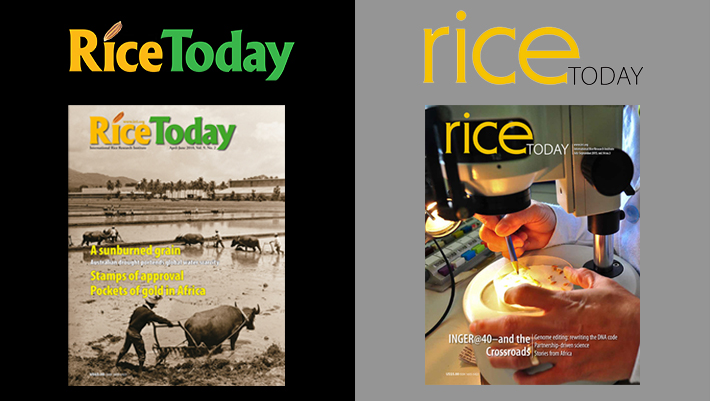Rice Today has indeed evolved from an IRRI-centric magazine into a truly global magazine—as the official publication of the Global Rice Science Partnership.
Part of this evolution is the re-working of the magazine’s masthead. The idea behind the “new look” is to make Rice Today more up-to-date, reflect new ways of finding solutions to the problems in rice production, and represent the advances in rice science. Along with the new look, we are expanding the magazine’s reach through Facebook and Twitter, and here in our new online abode.
We made these changes to bring you a better experience in accessing our information through the platform that best suits your needs. Whether you want to read about rice on paper or pixels, in your reading room or on mobile devices, our mission remains the same: tell great stories about the world of rice—from gene discoveries to the significant events in the global rice market.
And, in the new era of genomic research, we are featuring “genome editing” technology, the latest tool in the rice breeders’ toolbox, which enables the rapid rewriting of the DNA code to produce better varieties in the shortest time possible.
An example of a new variety with a success story under its belt is the salt-tolerant Salinas 11. It is helping Filipino farmers in Bohol Province of the Philippines cope with seawater encroaching on their paddies (See Rice against the tide.
The Bohol story (Rice against the tide) may sound anecdotal on how the Philippines, where IRRI is located, is benefiting from the Institute. Despite these success stories remains the fact that the Philippines is still a major rice importer. So the question remains, Is proximity to IRRI an advantage?
Citing India as an example, IRRI Director General Robert Zeigler explains how High science and smart policies will alleviate hunger and poverty.
Our Rice Map takes a first look at Asia’s rice crop, with Sentinel-1A satellite imagery, which provides detailed information on area planted to rice, cropping intensity, and even area damaged by floods or drought.
With increasing population and decreasing agricultural land area, the challenge for rice cultivation is to meet future food demand. One key strategy for obtaining sufficient future food production is to close “yield gaps.” But what is a yield gap? What are the sustainability implications of closing rice yield gaps? Alex Stuart, IRRI postdoctoral fellow, answers these questions in his Grain of truth.
Closing yield gaps, among other goals, in the rice sector will not be possible without the support of partners around the globe. The good news is that IRRI’s partners are taking it to the next level—from research beneficiaries to research investors. (See Partnership-driven science.)
Speaking of partnerships, IRRI is working with the Odisha University of Agriculture and Technology in India through a scholarship program in Developing the next breed of scientists.
In How long can the rice market defy El Niño? Dr. Samarendu Mohanty, IRRI senior economist, analyzes whether the rainfall disruption in India, Indonesia, and the Philippines will affect the direction of the rice market in the remaining months of 2015.
Then, we stepped back through time to look at the 40 years of contribution of the International Network for Genetic Evaluation of Rice (see INGER@40—and the crossroads). Aside from the varieties released in 74 countries, the pooled test materials from different countries have brought much-needed genetic diversity to farmers’ fields.
In Latin America, Edward Pulver, a renowned agronomist, has set an example and inspired young scientists around the world through his remarkable career. Dr. Pulver has dedicated his professional life to raising rice yields in the region with improved agronomic practices and “water harvesting.” (See Edward Pulver: Searching for the heart of yield.)
Our features from Africa are about The origins of Senegal’s dependency on rice imports , Côte d’Ivoire as an emerging rice powerhouse in West Africa, and why Tanzania is poised to lead Africa’s rice production.
And, on a lighter note, there’s a hearty debate who makes the better Jollof, the Ghanaians or the Nigerians? You can taste one side of the good-natured debate by learning how to cook Ghanaian Jollof rice.
Happy reading!
Ms. Lanie Reyes is the managing editor of Rice Today.










